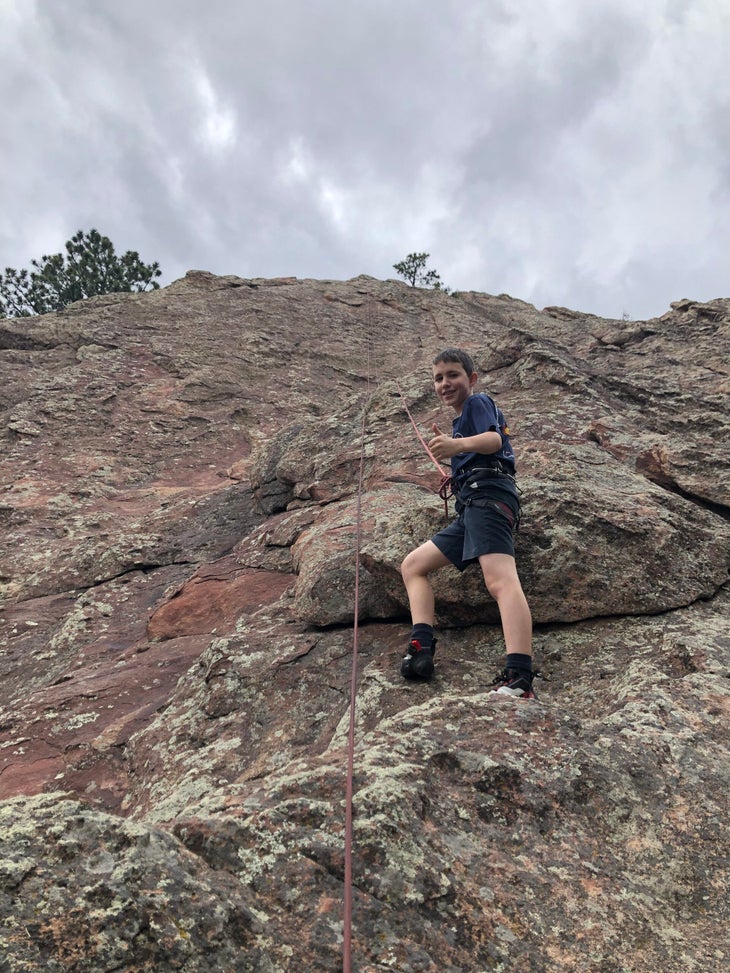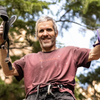Matt Samet: “Life is Short; Get Up There and Try Your Damnedest”
After saving a fallen cyclist, a lifer reflects on his own goals, illogical fears, and life's finite opportunities.
Heading out the door? Read this article on the new Outside+ app available now on iOS devices for members! Download the app.
On a cool, cloudy Saturday this May I was on the phone with my wife, driving up Table Mesa Drive to the National Center for Atmospheric Research (NCAR), the main access point for the central Flatirons, Colorado. Up at the lot, I’d be meeting my older son and his church scouting troop to take the boys toproping on one of the formations along the Mallory Cave Trail. Table Mesa climbs steeply through a suburban neighborhood before breaking out into the broad, grassy meadows sloping up to NCAR, and has become a popular climb with cyclists. Driving slowly up a steep pitch near the top of the neighborhood, I drifted toward the center line to avoid a small pack of bikers—if you drive in Boulder, it’s a reflex during the warmer months, when the “Lycra Tsunami” floods the roads.
“Hold on—shit,” I told Kristin just a few seconds later. “I gotta go. A cyclist is hurt.”
We’d been talking logistics for the day, as parents often (Always! Only!) do, when I’d glanced in my rearview mirror after passing the bikers. Now one of them lay crumpled in the road. Had I hit him? I hadn’t felt a thing, but maybe my car had kicked up a rock or loose piece of asphalt. I wheeled around and parked, turning my hazard lights on and running over to where an older gentleman, perhaps in his seventies, lay curled in a fetal position atop a toppled road bike. Two of his friends stood there, confused, calling his name and trying to rouse him. The man was struggling to breathe, his eyes rolled up in his head.
“Should I call 911?” I asked them—yes, I know, a dumb and obvious question, but when the very bad things happen, our faculties tend to shut down. It was all so surreal: this cyclist in the road, suddenly, inexplicably in a bad way, while all around was Saturday-morning suburban tranquility—the well-kept cars in leaf-blown driveways, the rain-saturated bright-green lawns, the tidy flowerbeds, the dog walkers, the cyclists on their weekend outings. I punched the three digits into the phone, reported our location to the dispatcher, and told her a cyclist had had what looked like a cardiac event.
“Tell her that he had major heart surgery four years ago,” said one of the man’s friends. “And that he has a pacemaker.”
*****
On March 22, 2021, a man went to the King Soopers grocery store about a mile down Table Mesa Drive from where we now stood and fatally shot 10 people—some in the parking lot, others inside the store.
It was the standard story: The killer had an AR-15–style gun and wore body armor; he engaged in a shootout with the police, killing one officer, and was taken into custody. He still has not been put on trial due to a lack of mental competency. There was nothing remarkable about that particular grocery store, and the shooter’s motives have yet to be made clear. But, in the end, none of this matters—the tragedy was just another entry in the ongoing ledger of senseless American mass shootings. A very bad thing emerged from nowhere, and for weeks afterward people made a pilgrimage to the sidewalk along the lot, now fenced in, leaving art and poems and letters and teddy bears. My friends and I would see the tribute wall each time we drove by to climb, until eventually the City of Boulder collected the sun-bleached memorabilia and carted it away.
Two years had gone by, and the King Soopers had been renovated. I sometimes stopped there to shop on the way home from climbing, barely registering the past horror. (One anecdote that stuck with me, that my friend Ryan heard from someone who knew a survivor: This person had hidden on a shelf in the chip aisle, covering themselves with the bags while the shooter stalked the store, smelling the blood of the dead while trying desperately not to rustle the chip bags and reveal their location.) Life, after all, is for the living, and pretty much the only way to get through the day is to avoid thinking about just how easy it is to die, how sudden and unannounced and unfair and random death can be, how it stalks us at every moment if we really stop to think about it.
“I didn’t hit him, did I?” I asked the man’s riding partners.
“No,” said one of them. “We were just laughing and joking, and the next thing I knew he fell off his bike.”
The 911 dispatcher asked questions about the man’s condition, which was clearly becoming more dire with each passing second. His friends had their hands on his shoulder, calling his name again, gently shaking him, but he still wasn’t responding and his face had taken on a worrisome purple color. Then he stopped breathing entirely.
*****
“Get him on his back! Get him on his back!” someone yelled. A small crowd had gathered to help—other cyclists, walkers, passing motorists. We rolled the man over.
“He needs chest compressions,” I told the dispatcher. “He isn’t breathing.”
“OK, I’m going to walk you through this,” she said. “I need you guys to do this right.” I put the phone on speaker. Just as one of the man’s friends was leaning in to administer CPR, a young woman with dark hair ran over. At first, I thought she was saying, “Is that my dad?” which seemed like an impossible coincidence. But then I realized she was asking, “Is he dead?”
“No,” I said. “I don’t think so.”
“I work in medicine,” she said. “I’ll do it.”
She leaned over, placed one palm flat on his chest, and began rapidly pumping it up and down with her other palm. Some seconds later—and really, I had no idea of time at this point—the man began to breathe, sighing and moaning, alive again, his breath rattling in his throat. Another woman joined us—an anesthesiologist, she said—and began directing our efforts as different people rotated in to give chest compressions. The man’s heart was beating, the anesthesiologist said, checking his carotid artery, but his pulse was weak. She had me hold his head with gentle traction, to keep his airway open, which I did for five minutes, encouraging the man, telling him he was doing great and that the ambulance would be there soon. I was sore from training at the climbing gym the day before, but I barely noticed, I was so flooded with adrenaline. It was only when I released the man’s head to the care of the EMTs that I realized how cramped, leaden, and wracked with pain my arms and shoulders were.
*****
I don’t know what became of the cyclist and probably never will—these sorts of things don’t make the news cycle. My son and the other boys—who were in a car coming up Table Mesa Drive, waiting while the police stopped traffic for the EMTs—had, they told me when we regrouped at NCAR, prayed for the man. And it is certainly my hope that their faith had a salubrious effect. The boys had questions about what had happened, and I did my best to give answers that weren’t too graphic or scary. But the truth was, I was shaken up. So while our toproping session that day came off without a hitch, I had to fight to stay buttoned-up. Even now, two weeks later, I still have flashbacks, especially at night as I try to sleep. The man had a pulse and was breathing when I drove off, but I have no idea if he survived.

But I do know this: This cyclist was 74 (his friends told me his age, to relay to the dispatcher), he’d already had one major heart surgery, he had a pacemaker, and yet here he was on his bike grinding up the NCAR hill because this was what he did. This was what mattered to him.
Around this same time, I’d been projecting a route at Hillbilly Rock, a pyramidal flatiron about a mile above NCAR. The route is a link-up of two existing climbs and originally had a big runout at the crux, which would send you for a 35-foot penduluming fall if you missed the last hard, leftward stab. I’d gotten permission from the FA party and from the City to add a bolt to the traverse—and had done so—but I was still climbing up into the crux, chickening out, and calling for a take. Then I’d promptly hang, rest, and go to the top. Physically, I was there; psychologically, I was not, battling an illogical “high-fear” period during which even toprope whippers were terrifying.
[Read: 8 Father’s Day Splurges for the Dads in Your Life]
But after that Saturday, this shifted. What was I—only 51, in good health, and having trained all winter specifically for climbs like this one, which pushed me to my resistance edge—doing giving up like some half-assed loser on a perfectly safe sport climb? Did I not realize that there would not, in fact, be infinite opportunities to redpoint this route? That between conditions, fitness, finding partners, work, dad life, summer travel, and of course the fact that I could, like any of us, die at any moment, I might not get as many chances as I hoped?
It is a lesson I seem to need to relearn once or twice a year: Life is short; get up there and try your damnedest—not because I care about taking an “impressive ticklist” to the grave (I guarantee God doesn’t care how many 5.14s you’ve done), but because the process of trying my hardest, and eventually succeeding, has always made me feel most alive. It’s what keeps all of us coming back to drink at the trough, I suspect.
Our daughter was born in August 2021 two months before I turned fifty, an age that represents a real reckoning with mortality. Hers was a normal hospital birth, with no projected complications, but she was a big baby—nine-plus pounds—and she came out purple and long-limbed and floppy and silent, neither crying nor screaming, breathing almost imperceptibly. Kristin held her and we cut the cord, then a delivery nurse rushed her onto the warming table to suction out her airways with a bulb while Kristin looked on from the bed, sweaty and exhausted.
“Is she breathing OK?” Kristin asked.
“I’m not sure,” I said. “I don’t think so—at least not yet.”
I placed my hand on the belly of this nameless baby, not yet one minute in the world, and told her that I loved her and that I was glad she was here. Seconds later, she coughed and spluttered; her chest rose and fell. She gave a hearty cry. In that moment, our daughter came alive; in that moment, life happened.
Matt Samet is a freelance writer/editor and longtime climber based in Boulder, Colorado.
Also Read:
- My Family’s Not that into Climbing—And That’s OK
- The Splitter Cracks and Mind-Boggling Movement in Unaweep Canyon
- Tales from Climbing on Moro Rock in Sequoia National Park
